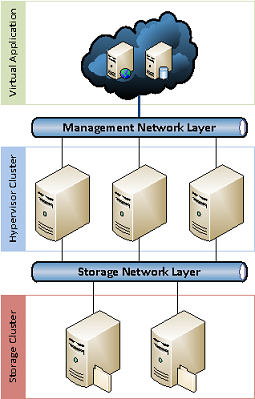
Virtualization
The concept of hardware virtualization plays a key role in our solution planning as it assists with providing a scalable infrastructure base and allows for improving application uptime through the use of High Availability technology. Treating your entire application infrastructure as a virtual entity offers many advantages over traditional usage of dedicated hardware which cannot effectively scale with growth. At the core of our service design is the hypervisor kernel, integrating each hardware node into a virtual cluster with redundant storage and network resources. Our preferred hypervisor vendors include Citrix and VMware, each offering their own mix of features and benefits which are reviewed by our engineers to determine the best fit for the planned solution.
- Providing a scalable infrastructure base
- Allows for High Availability and redundancy options
- Creating a virtual resource cluster for efficiency
- Enterprise level hypervisor offerings from Citrix and VMware
Logical Diagram

- Redundant storage array utilizing layers such as AoE, FCoE, FCP
- Cluster of hypervisor nodes with management network layer
- Virtualized applications running within the hypervisor cluster
Considerations
Design and deployment of virtualization clusters requires review of several considerations to determine correct vendor selection and feature support for the infrastructure needs. We review considerations both within the virtual application layer and on the supporting infrastructure layer to eliminate compatibility faults during deployment. Cases including more advanced storage needs will require compatibility review for node hypervisor support as well as SAN structure for cluster connectivity. Further considerations include advanced deployments within the High Availability model such as requirements for multiple site data replication for wide area geographical redundancy. These considerations must also be compatible with the virtual applications deployed within virtualized clusters, and Altexxa Group will work with vendors and lab testing to ensure needs are met by design.
- Review of both virtual application and infrastructure layers
- Considerations for advanced storage and replication needs
- Working within High Availability and redunancy models
- Ensuring accurate design by working with vendors and labs
Deployment
For deployment of virtualized hypervisor clusters, Altexxa Group primarily utilizes the Citrix XenServer and VMware ESXi platforms. Nodes within virtualized clusters also feature direct connectivity to clustered storage solutions with redundancy protocols. Further network segregation is done between management layers and external routed traffic to minimize impact from High Availability and failover tasks as virtual applications perform migrations between virtualized nodes. Multiple network trunk lines will exist between our aggregate network layer and virtualized clusters. Physical hypervisor nodes will include hardware redundancy to protect against critical failures.
Altexxa Group believes automation of node clusters will also play a key role in virtualization deployments, and we will work with software orchestration to enable provisioning and maintenance tasks to occur within clusters. We also utilize profile driven cluster compliance to ensure configurations remain static across virtualized nodes.
- Direct connection to storage clusters utilizing redundancy protocols
- Following redundancy model across network and physical deployment
- Automation systems and profile driven deployments for compatibility
Advantages
There are several advantages to adopting a virtualization platform to support your application deployment. Virtualization clusters have the capability to scale with application growth and offer additional levels of redundancy compared to standalone systems. System administrators are also able to perform node-level maintenance tasks without impacting service uptime as the application resource load would dynamically shift across the remaining nodes within the virtualization cluster. Fault tolerance within the cluster also allows for applications to remain running should the hardware infrastructure suffer a failure.
- High Availability and Fault Tolerance capabilities on virtualization cluster
- Scalable infrastructure for application growth requirements
- Fast provisioning and deployment using software level orchestrator
- Compatibility for multiple OS types on a single virtual cluster
- Ideal for high-density models to improve ROI and reduce carbon footprint
